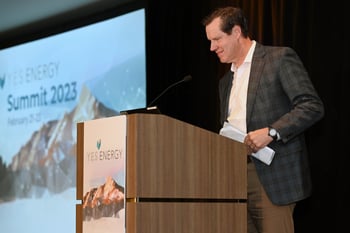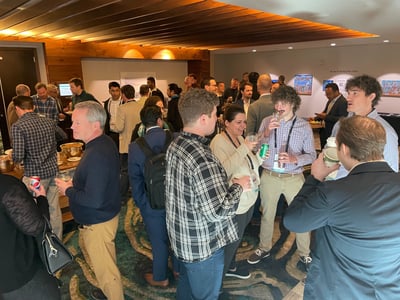Share this
Summit 2023 Highlights
by Yes Energy
Over 180 customers joined us in Boulder, CO, for our 15th annual Yes Energy Summit. From keynotes by Peter Kelly-Detwiler and Dr. Kyri Baker to sessions on changing ISO market dynamics and the changing technology and regulatory landscape, Summit 2023 was our biggest and best yet! Here are a few highlights from our time together.
Changing ISO Market Dynamics
Our first day opened with an inspiring talk by Yes Energy founder Michael McNair covering the trajectory of nodal power markets. We’re at a pivotal point in the  energy transition, with a threefold expected increase in our dependence on electricity and the grid. In the near future, we see billions of new devices and appliances increasing power demand as well as improving efficiency. NREL forecasts total power demand could rise 65% by 2050. As we work to optimize today’s grid as well as build tomorrow’s, collaboration is key. We all have work to do, from data scientists, asset managers, traders and regulators working separately as well as together to ensure a seamless transition.
energy transition, with a threefold expected increase in our dependence on electricity and the grid. In the near future, we see billions of new devices and appliances increasing power demand as well as improving efficiency. NREL forecasts total power demand could rise 65% by 2050. As we work to optimize today’s grid as well as build tomorrow’s, collaboration is key. We all have work to do, from data scientists, asset managers, traders and regulators working separately as well as together to ensure a seamless transition.
Energy expert Peter Kelly-Detwiler followed McNair’s session with a terrific keynote detailing 10 things that need to happen to enable the energy transition. (Look for our upcoming blog on Kelly-Detwiler’s keynote.)
Afternoon highlights included a presentation by an international and domestic tax attorney assessing the Inflation Reduction Act’s impact on energy storage development, a lively panel on battery optimization, and an analysis of Winter Storm Elliot’s impact on the power grid.
 Although industry experts expected ERCOT and SPP to follow Winter Storm Uri’s disastrous trajectory, our analysis shows that the Northeast was hit the hardest during Elliot’s December 2022 bomb cyclone. SPP unexpectedly coasted through an all-time winter peak load while PJM’s CCGT fleet failed during an abnormally high holiday load. As we scrutinized ERCOT’s performance, we found low reserves while solar helped save the day. Meanwhile, day-ahead economics left gas out of the cold weather equation in NEISO and outages pushed them to capacity condition.
Although industry experts expected ERCOT and SPP to follow Winter Storm Uri’s disastrous trajectory, our analysis shows that the Northeast was hit the hardest during Elliot’s December 2022 bomb cyclone. SPP unexpectedly coasted through an all-time winter peak load while PJM’s CCGT fleet failed during an abnormally high holiday load. As we scrutinized ERCOT’s performance, we found low reserves while solar helped save the day. Meanwhile, day-ahead economics left gas out of the cold weather equation in NEISO and outages pushed them to capacity condition.
In our congestion-focused sessions, we explored how the changing generation stack is impacting independent system operator (ISO) market dynamics and congestion patterns. In the past six years, the U.S. has increased wind and solar by almost 100 k MWs, leading to most ISOs doubling their wind and solar capacity. Renewables contribute to congestion since they’re non-dispatchable and generally far from the load. Since our grid isn’t built for this level of dispersed generation, ISO congestion costs are rising, and curtailment and negative pricing events are increasing. Our analysis showed that CAISO, MISO, and SPP have seen large increases in congestion. Recent congestion increases in MISO and SPP have been primarily driven by wind.
Changing Technology and Regulatory Landscape
Dr. Kyri Baker from the University of Colorado kicked off our second day with a keynote on the utility of AI/ML for complex energy systems.” Although traditional forecasting techniques use limited inputs to forecast demand, deep learning can  have a lot more variables and uncover relationships that may not seem obvious to the human eye. Baker explored how we can “teach” current operational algorithms to use previous knowledge in order to strengthen the grid. Although machine learning (ML) and artificial intelligence (AI) can simultaneously be buzzwords and extremely useful for society, she reminded us, they are not a panacea. Pitfalls with available and representative data and incorrect perceptions of ML/AI capabilities can result in adverse consequences.
have a lot more variables and uncover relationships that may not seem obvious to the human eye. Baker explored how we can “teach” current operational algorithms to use previous knowledge in order to strengthen the grid. Although machine learning (ML) and artificial intelligence (AI) can simultaneously be buzzwords and extremely useful for society, she reminded us, they are not a panacea. Pitfalls with available and representative data and incorrect perceptions of ML/AI capabilities can result in adverse consequences.
Next, our trading and risk team covered trends in the FTR Markets, including an analysis of the 2022 market performance. We also mapped forward positions in the market, showing how FTR market information can be used to compare our performance to market peers, map risk usage to other market competitors and explore how different segments change in value from auction to auction. Yes Energy’s FTR positions dataset enable our customers to outsource expensive data management, eliminating a need for internal IT, and saving them time and money when they analyze positions, performance and market risks.
Another highlight was an overview on key ISO market changes by our marketing monitoring team. We covered changes to PJM’s ancillary services markets, with a  new tiered structure adding a 30-minute reserve product in the RT market, fairer compensation in the Day Ahead market, increased market efficiency, and flexible subzones creating more hedging opportunities. Meanwhile ERCOT’s ancillary services changes increased reliability services and thus reserve margins, opened the door for more technologies to participate, and created better price formation and clearer economic signals. New sources of battery storage data and market expansions were also addressed, as were their implications on data collections.
new tiered structure adding a 30-minute reserve product in the RT market, fairer compensation in the Day Ahead market, increased market efficiency, and flexible subzones creating more hedging opportunities. Meanwhile ERCOT’s ancillary services changes increased reliability services and thus reserve margins, opened the door for more technologies to participate, and created better price formation and clearer economic signals. New sources of battery storage data and market expansions were also addressed, as were their implications on data collections.
Our market monitoring team continued its regulatory focus by analyzing PJM’s FTR market before and after changes stemming from the GreenHat 2018 default. With $160 million defaulted, and a portfolio of 890 million MWh worth of contracts, PJM saw a need for a more resilient market. As such, they raised the minimum offer to $1, increased the bid limit by 50%, and split the OffPeak PeakType into two new peaktypes in order to increase market liquidity and create more hedging opportunities. Yes Energy started tracking PJM’s FTR peak market changes in October 2021, nearly a full year before it went live, allowing our market monitoring team and engineers to safeguard our clients’ workflows when the changes went live this past September. Here’s what that looks like on the inside: we added new tables to accommodate the new peaktypes and backfilled the data to 2015, earmarking 300 hours and loading more than 150 million rows in order to fully integrate the two new peaktypes for both historical analysis and future auctions. In the 5 months since the peaktype change, our team has seen positive overall impacts in the market, suggesting a competitive future ahead.
We closed out our second day with the evolving North American power markets,  exploring IESO’s delayed Market Renewal Program–now expected in 2025–transforming IESO into a fully nodal market. SPP and CAISO's expanded RT markets are also growing, with WEIS and the WEIM adding three new entrants each this April. SPP’s Markets + program development continues on track, with a launch expected in late 2024. CAISO’s extended day-ahead market (EDAM) development also continues to move forward, with this DAM addition expected to launch in late 2024, and onboarding to follow in Spring of 2023. Many of these market expansions are occurring in western markets, fueling the trajectory of the west as a whole. With these market evolutions occurring in tandem, we see a push towards more efficient markets and greater regional collaboration in times of uncertainty. Which brings us back to Michael McNair’s presentation: collaboration is key as we move forward with market and grid expansion.
exploring IESO’s delayed Market Renewal Program–now expected in 2025–transforming IESO into a fully nodal market. SPP and CAISO's expanded RT markets are also growing, with WEIS and the WEIM adding three new entrants each this April. SPP’s Markets + program development continues on track, with a launch expected in late 2024. CAISO’s extended day-ahead market (EDAM) development also continues to move forward, with this DAM addition expected to launch in late 2024, and onboarding to follow in Spring of 2023. Many of these market expansions are occurring in western markets, fueling the trajectory of the west as a whole. With these market evolutions occurring in tandem, we see a push towards more efficient markets and greater regional collaboration in times of uncertainty. Which brings us back to Michael McNair’s presentation: collaboration is key as we move forward with market and grid expansion.
How We Can Work Together to Support the Energy Transition
As we transition toward a cleaner and more robust grid, high-quality energy market data is a key ingredient of the energy transition.
At Yes Energy, we provide the most comprehensive and robust energy market data and analytic tools available. To learn how we can help your company confidently navigate wholesale power market data and maximize your bottom line, schedule a demo today.
Share this
- Industry News & Trends (97)
- Power Traders (74)
- Data, Digital Transformation & Data Journey (44)
- Asset Managers (39)
- Market Events (30)
- Asset Developers (29)
- ERCOT (26)
- Market Driver Alerts - Live Power (25)
- Utilities (25)
- ISO Changes & Expansion (22)
- Renewable Energy (22)
- Infrastructure Insights Dataset (21)
- PowerSignals (21)
- DataSignals (17)
- Energy Storage / Battery Technology (17)
- Live Power (17)
- Risk Management (17)
- Yes Energy Demand Forecasts (17)
- Data Scientists (15)
- CAISO (13)
- PJM (11)
- MISO (9)
- Power Markets 101 (9)
- QuickSignals (9)
- SPP (9)
- EnCompass (8)
- Position Management (8)
- Submission Services (8)
- Financial Transmission Rights (7)
- Snowflake (6)
- Powered by Yes Energy (5)
- Asset Developers/Managers (4)
- Data Centers (4)
- FTR Positions Dataset (4)
- Geo Data (4)
- Solutions Developers (4)
- Commercial Vendors (3)
- Battery Operators (2)
- ISO-NE (2)
- Independent Power Producers (2)
- NYISO (2)
- PeopleOps (2)
- data quality (2)
- AI and Machine Learning (1)
- Crypto Mining (1)
- Europe (1)
- FERC (1)
- Ireland (1)
- Japanese Power Markets (1)
- Natural Gas (1)
- Western Markets (1)
- hydro storage (1)
- nuclear power (1)
- January 2025 (5)
- December 2024 (4)
- November 2024 (7)
- October 2024 (6)
- September 2024 (5)
- August 2024 (8)
- July 2024 (9)
- June 2024 (5)
- May 2024 (7)
- April 2024 (8)
- March 2024 (6)
- February 2024 (9)
- January 2024 (5)
- December 2023 (4)
- November 2023 (5)
- October 2023 (6)
- September 2023 (2)
- August 2023 (6)
- July 2023 (3)
- May 2023 (4)
- April 2023 (2)
- March 2023 (2)
- February 2023 (2)
- January 2023 (5)
- December 2022 (2)
- November 2022 (1)
- October 2022 (3)
- September 2022 (5)
- August 2022 (5)
- July 2022 (3)
- June 2022 (3)
- May 2022 (1)
- April 2022 (3)
- March 2022 (3)
- February 2022 (6)
- January 2022 (3)
- December 2021 (2)
- November 2021 (4)
- October 2021 (4)
- September 2021 (3)
- August 2021 (2)
- July 2021 (4)
- June 2021 (5)
- May 2021 (3)
- April 2021 (3)
- March 2021 (4)
- February 2021 (3)
- December 2020 (3)
- November 2020 (4)
- October 2020 (2)
- September 2020 (5)
- August 2020 (2)
- July 2020 (2)
- June 2020 (1)
- May 2020 (9)
- November 2019 (1)
- August 2019 (2)
- June 2019 (2)
- May 2019 (2)
- January 2019 (1)




